Tricuspid atresia echocardiography: Difference between revisions
(/* ACC/AHA 2008 Guidelines for the Management of Adults With Congenital Heart Disease (DO NOT EDIT){{cite journal| author=Warnes CA, Williams RG, Bashore TM, Child JS, Connolly HM, Dearani JA et al.| title=ACC/AHA 2008 Guidelines for the Management of Adults with Congenital Heart Disease: Executive Summary: a report of the American College of Cardiology/American Heart Association Task Force on Practice Guidelines (writing committee to develop guidelines for the management of adults with conge...) |
|||
| Line 6: | Line 6: | ||
Echocardiography is the imaging modality of choice for tricuspid atresia. Findings include: | Echocardiography is the imaging modality of choice for tricuspid atresia. Findings include: | ||
* [[Atrial septal defect]] (ASD) | * [[Atrial septal defect]] ([[ASD]]) | ||
* [[Ventricular septum defect]] (VSD) | * [[Ventricular septum defect]] ([[VSD]]) | ||
* [[Patent ductus arteriosus]] (PDA) | * [[Patent ductus arteriosus]] ([[PDA]]) | ||
* [[Aortic arch]] anomaly | * [[Aortic arch]] anomaly | ||
* The[[ left ventricle]] is larger than the [[right ventricle]] | * The[[ left ventricle]] is larger than the [[right ventricle]] | ||
Revision as of 15:37, 24 August 2020
|
Tricuspid atresia Microchapters |
|
Diagnosis |
|---|
|
Treatment |
|
Special Scenarios |
|
Case Studies |
|
Tricuspid atresia echocardiography On the Web |
|
American Roentgen Ray Society Images of Tricuspid atresia echocardiography |
|
Risk calculators and risk factors for Tricuspid atresia echocardiography |
Editor-In-Chief: C. Michael Gibson, M.S., M.D. [1]; Associate Editor-In-Chief: Sara Zand, M.D.[2]Keri Shafer, M.D. [3] Priyamvada Singh, MBBS [4]; Assistant Editor-In-Chief: Kristin Feeney, B.S. [5]
Overview
Echocardiography is the imaging modality of choice for tricuspid atresia. Findings include:
- Atrial septal defect (ASD)
- Ventricular septum defect (VSD)
- Patent ductus arteriosus (PDA)
- Aortic arch anomaly
- Theleft ventricle is larger than the right ventricle
- Color flow doppler is absent between theright atrium and right ventricle
Echocardiography
Shown below is an ECHO image demonstrating atresic tricuspid valve and ventricular septal defect.

Shown below is a short video of an echocardiogram of a patient with tricuspid atresia.
{{#ev:youtube|0FU2Y6zUvOE}}
Shown below is a short video of an echocardiogram of a 24 year old patient with tricuspid atresia.
{{#ev:youtube|Y4arA4kAzjk}}
Shown below is a echocardiogram of a 20 day old neonate with tricuspid valve atresia. This congenital anomaly is not compatible with life unless there is a right-to-left shunt. In the case presented below, there is VSD and ASD, and it represents about 1% of all congenital anomalies.
{{#ev:youtube|x8RpQiG-cs0}}